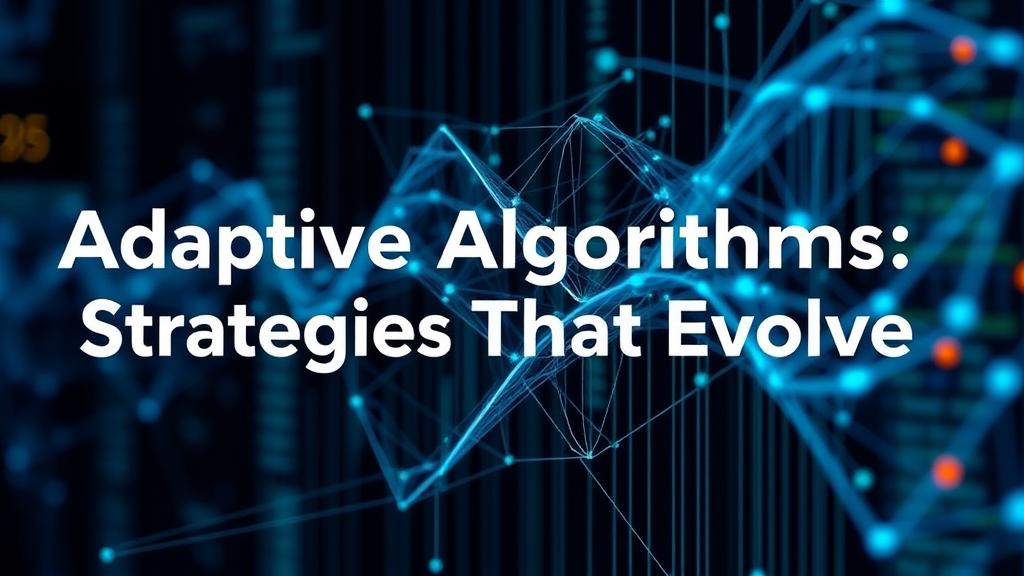Prompting Readers to Consider New Possibilities
What if your trading strategies could react in milliseconds? Algorithmic investing makes this possible—let’s explore the potential.
Adaptive Algorithms: Strategies That Evolve
In a world where data is expanding at an unprecedented rate, the need for intelligent systems that can learn, adapt, and improve over time is more crucial than ever. Enter adaptive algorithms—powerful tools that enable computers to adjust their strategies based on new information and experiences. In this article, we will explore what adaptive algorithms are, how they work, their applications, and the different strategies they employ. By the end, you will have a deeper understanding of these dynamic systems and their significance in various fields.
Adaptive algorithms are computational methods designed to modify their behavior in reaction to changes in their environment or input data. Unlike static algorithms that follow a predetermined set of rules, adaptive algorithms learn from the data they process, improving their performance over time.
Key Characteristics of Adaptive Algorithms
- Learning Ability**: They can learn from past experiences and refine their processes.
- Flexibility**: They adapt to new data or changes in the environment.
- Efficiency**: They often optimize their performance based on feedback.
How Do Adaptive Algorithms Work?
Understanding how adaptive algorithms function requires a glimpse into their core mechanisms. These systems generally work through the following processes:
1. Data Collection
Adaptive algorithms rely on data to learn and adapt. This data can come from various sources, such as user interactions, sensor inputs, or historical records.
2. Model Initialization
Initially, the algorithm starts with a basic model or a set of assumptions. This model serves as a baseline for making predictions or decisions.
3. Learning Process
- Feedback Loops**: The algorithm receives feedback on its performance. This feedback can be in the form of rewards or penalties, which guide the learning process.
- Parameter Adjustment**: Based on the feedback, the algorithm adjusts its parameters to improve accuracy. Techniques like gradient descent are often employed here.
- Iteration**: The process is repeated multiple times, allowing the algorithm to refine its model continuously.
4. Deployment
Once the algorithm has sufficiently learned from the data, it can be deployed to make predictions or decisions in real-time scenarios.
Strategies Employed by Adaptive Algorithms
Adaptive algorithms can utilize various strategies depending on their objectives and the nature of the data. Here are some of the most common strategies:
1. Reinforcement Learning
Reinforcement learning is a type of machine learning where an agent learns to make decisions by taking actions in an environment to maximize cumulative rewards.
- Example**: In a game setting, an algorithm might learn to play chess by receiving positive feedback for winning moves and negative feedback for losing moves.
2. Genetic Algorithms
Inspired by the process of natural selection, genetic algorithms employ mechanisms such as selection, crossover, and mutation to evolve solutions to optimization problems.
- Example**: These algorithms can be used in engineering design, where multiple design solutions are evaluated and evolved over generations to find the most efficient one.
3. Adaptive Control Systems
Adaptive control systems adjust their control parameters automatically in response to changes in system dynamics.
- Example**: In robotics, adaptive control can help a robot adjust its movements based on the terrain it encounters, ensuring smoother navigation.
4. Ensemble Learning
Ensemble learning combines multiple models to improve performance. Adaptive algorithms can modify the contribution of each model based on their performance.
- Example**: In predictive analytics, multiple algorithms can be used to predict stock prices, with the ensemble adjusting weights according to the accuracy of each individual model.
5. Online Learning
Online learning algorithms process data in real-time as it arrives, enabling them to adapt quickly to new information.
- Example**: Email filtering systems that learn from user actions (e.g., marking emails as spam or not) continuously adjust their filters to improve accuracy.
Real-World Applications of Adaptive Algorithms
Adaptive algorithms have found applications across various sectors, demonstrating their versatility and effectiveness. Here are some noteworthy examples:
1. Healthcare
In healthcare, adaptive algorithms are used in predictive analytics to identify potential health risks based on patient data, allowing for personalized treatment plans.
- Example**: Algorithms can analyze historical patient data to predict the likelihood of diseases, enabling preventive measures.
2. Finance
In the financial sector, adaptive algorithms are employed for algorithmic trading. They analyze market trends and execute trades based on evolving data.
- Example**: High-frequency trading systems adapt their strategies in real time based on market fluctuations, maximizing profits.
3. Marketing
Adaptive algorithms play a critical role in targeted advertising by analyzing user behavior and preferences to deliver personalized content.
- Example**: Recommendation systems on platforms like Netflix or Amazon adjust their suggestions based on user interactions and ratings, improving user experience.
4. Autonomous Vehicles
In the field of autonomous driving, adaptive algorithms are essential for navigation and obstacle avoidance.
- Example**: Self-driving cars utilize adaptive learning to improve their driving strategies based on real-world scenarios and traffic patterns.
5. Cybersecurity
Adaptive algorithms enhance cybersecurity measures by detecting anomalies in network traffic and adjusting defense mechanisms in real-time.
- Example**: Intrusion detection systems can learn from previous attacks and adapt to recognize new threats more effectively.
Challenges and Future Directions
Despite their many advantages, adaptive algorithms face several challenges:
1. Data Quality and Availability
The performance of adaptive algorithms is heavily reliant on the quality and quantity of data. Inaccurate or insufficient data can lead to poor learning outcomes.
2. Overfitting
There’s a risk that an adaptive algorithm may become too tailored to the training data, failing to generalize well to new data.
3. Ethical Concerns
As these algorithms become more prevalent, ethical issues surrounding data privacy and algorithmic bias must be addressed.
Future Directions
As technology continues to evolve, the future of adaptive algorithms looks promising:
- Explainable AI**: Developing methods to make adaptive algorithms more transparent and understandable.
- Integration with IoT**: Combining adaptive algorithms with Internet of Things (IoT) devices to create smarter systems.
- Interdisciplinary Applications**: Expanding their use in fields like climate modeling, where adaptive algorithms can help optimize resource management.
Conclusion
Adaptive algorithms represent a significant leap forward in the field of artificial intelligence and machine learning. By learning from data and adapting to new information, these algorithms are reshaping industries and enhancing the way we interact with technology. As we continue to explore their potential, addressing the challenges they face will be crucial in ensuring they remain effective, ethical, and beneficial to society. The future of adaptive algorithms is bright, with endless possibilities for innovation and improvement.



